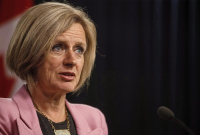Support strong Canadian climate journalism for 2025
The 2018 Ontario provincial election has delivered a majority government for the Progressive Conservative Party, gave the New Democrats official Opposition status and raised questions about the viability of the Liberal Party, which was reduced to single digits in seats.
A Research Co. exit poll, comprising the views of 503 Ontarians who cast a ballot in this electoral process, shows the different motivations of voters, as well as the effect of the events of the final week of campaigning, which included Premier Kathleen Wynne’s Saturday concession and the $16.5-million lawsuit filed by Rob Ford’s widow.
One of the traits that made this provincial election so compelling was the answer to the “time for change” question, especially when compared to other recent ballots. In Alberta and Manitoba, we saw many voters (82 per cent and 67 per cent respectively) embrace opposition leaders and abandon sitting governments. In Saskatchewan, the incumbent premier had little trouble holding on to a massive majority. In British Columbia, three-in-five voters wanted change in an election that resulted in a tie on the popular vote.
Ontario was decidedly different. More than three-in-five voters (77 per cent) said it was time for a change in government (five points lower than the 82 per cent observed in Alberta in 2015, and eight points higher than Manitoba in 2016). The sentiment for change was astonishingly high for both PC and NDP voters (94 per cent and 92 per cent respectively). However, one third of Liberal voters (33 per cent) also thought it was time for new leadership in the province, a sign of a base that perhaps grew unenthusiastic after the sitting premier acknowledged she would lose the election in the final weekend of the campaign.
Wynne’s plea for Liberal votes without a Liberal government seemed to split the public on the concept of “strategic voting”. Across the province, 45 per cent of Ontarians said they voted for the candidate in their riding who had the best chance of defeating a party they disliked, even if the candidate they voted for was not their first preference.
The proportion of “strategic voters” was highest among NDP supporters (55 per cent), who ended up becoming the official opposition. Andrea Horwath held a higher approval rating than the other three leaders in the last two weeks of the campaign, much in the same way Jack Layton posted impressive numbers on this question before the 2011 federal election. Both ended up taking their parties from third place to second place.
When it comes to the lawsuit against PC leader Doug Ford, the effect was negligible. Perceptions about the party’s leader were positive enough to facilitate a victory. When asked about six possible motivators for their vote, one-in-four PC voters (25 per cent) said the most important factor was “the party’s leader.” Among both Liberal and NDP voters, this factor was ranked lower, at 22 per cent.
Liberal voters were more likely to say the most important factor was “the party’s candidate in the riding” (20 per cent, compared to a paltry 10 per cent and seven per cent among NDP and PC voters respectively). Incumbent ministers and long-time serving legislators sought to establish a powerful connection with some of the Liberal base, especially after Wynne appealed for a balance of power.
“The party’s ideas and policies” is, by far, the most important factor for supporters of the three main parties (44 per cent for Liberals, 39 per cent for NDP and 34 per cent for PC). “Desire for change” moved 19 per cent of PC voters and 13 per cent of NDP voters, but the New Democrats also benefitted—although not enough to score an upset win—from the 15 per cent of voters who said “disgust with other contending candidates” was their main motivating factor—a far higher proportion than the PCs (10 per cent) and the Liberals (five per cent).
Finally, we look at the situation that led to Doug Ford becoming leader of the Progressive Conservatives. Among all voters in the election, 37 per cent said they would have voted for the Progressive Conservatives if Patrick Brown was still their leader. This includes 59 per cent of those who ended up casting a ballot for the Ford-led party, but also a sizeable proportion of Ontarians who ended up voting for the NDP (32 per cent) and the Liberals (27 per cent). This would suggest that Brown, even after the allegations that forced him to quit as leader, would have had a similar result as Ford.
Polling methodology: Results are based on an online study conducted on June 6 and June 7, 2018 among 503 Ontario adults who voted in the 2018 provincial election. The margin of error — which measures sample variability — is +/- 4.4 percentage points for the sample of decided voters, nineteen times out of twenty.
Results:






Comments